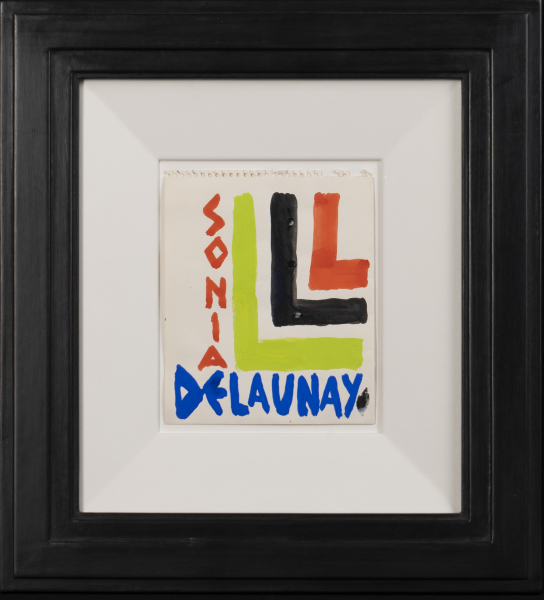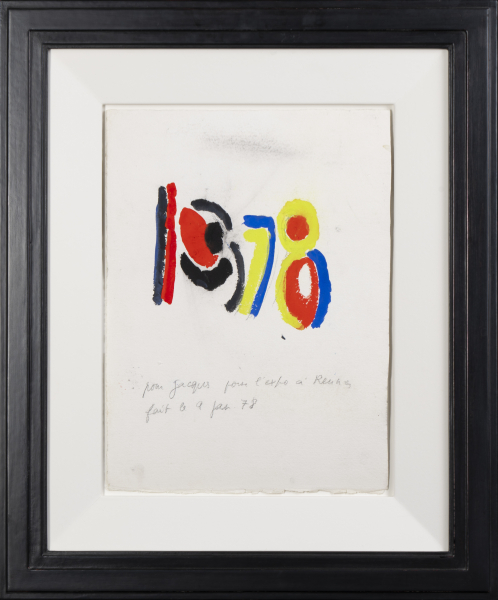Sonia Delaunay Gradischsk 1885 - 1979 Paris
PROJECT
AROUND 1969
- GOUACHE AND INK ON PAPER
- 17,5 X 14,5 CM FRAME: 42 X 38 CM
PROVENANCE
- ESTATE OF JACQUES DAMASE COLLECTION, FRANCE
Sonia Delaunay-Terk was born as Sarah Stern near Odessa (Ukraine) in 1885. She studied drawing in Germany and moved to Paris in 1905, where she met her future husband Robert Delaunay.
Sonia Delaunay was special: an innovator, inventor, originator and artisan. She created art and set things in motion. By instinct, she was a passionate proponent of the avant-garde. She created with her husband an unique style that can be understood as a fusion of Cubism and Futurism with very intense colors, called Orphic Cubism. The term Orphism or Orphic Cubism refers to a style of art that grew out of Cubism, creating primarily circular shapes in bright, pure colors. Color became its leitmotif. She erected a scaffolding of new impressions to reach not upward, but inward. A new emotional language that corresponds to the Futurist movement in Italy, the Constructivist in Russia and the Blue Rider in Germany. Sonia Delaunay is the root of modern art. Her works are filled with a transformation of the banal into the animate through color and its intensity. However, although her paintings are colorful, they are far from being "light" or simple. In fact, her concept of depth can be understood as an elevation of color and the seriousness of the subject. On August 22nd in 1949, she wrote down what could be considered as her credo:
"Until the present time, painting has been nothing but colored photography and color has always been used only to describe something. Abstract painting is a first step towards liberation from the old pictorial formula. But the truly new painting will begin only when people understand that color has an independent life of its own, that the infinite combinations of colors have a much more expressive poetry and language than the time- honored methods. It is a mysterious language, in harmony with the vibrations, indeed the life of color. In this field lie new and infinite possibilities.“
In 1964 she became the first living artist to receive a retrospective at the Louvre in Paris. In the same year she met the publisher Jacques Damase, who was considered an outstanding publisher of the most important artists of his time about Chagall, Braque and Picasso. Working together on exhibitions, catalogs, illustrated books, and preparing prints, Damase played a prominent role in promoting Delaunay's public recognition. After he and Delaunay became friends, he was responsible for a large number of valuable and lovingly designed books in limited editions.
One of the first major exhibitions held after her meeting with Damase was titled L'Expo 1925 and was held at the Musée des Arts Décoratifs in Paris, in 1965. A room was dedicated to Sonia's fabric designs and dresses, showing how defining her influence was in these fields during the 1920s. Thanks to Damase's help, she enjoyed the greatest tribute ever paid to her in 1967: A retrospective of her work at the Musée d'Art Moderne, comprising nearly 200 works. In addition, Sonia Delaunay wrote a work especially for Damase on the occasion of the exhibition at the Maison de la Culture in 1978, organized to celebrate the 30th anniversary of the Jacques Damase Editions. This exhibition was also held at the Centre Pompidou in 1979.
The work Delaunay gave Damase for this was probably the last work she executed.
A year later, Sonia Delaunay died peacefully in her studio on December 05th. Dressed in her floor-length blue velvet gown, which Hubert de Givenchy had designed for her on the occasion of the reception in honor of Queen Elizabeth II in Versailles, she was buried in the small cemetery of Gambais, right next to her husband's grave, which she had visited every year on the anniversary of his death.

